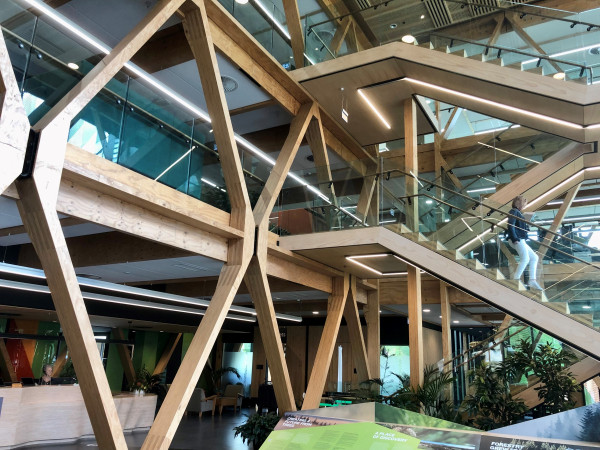Shaping tomorrow’s timber structures with NZS AS 1720.1:2022
Timber offers a renewable and carbon negative resource that can lead the way for the development of more innovative, sustainable and robust structures across New Zealand, now supported by newly published NZS AS 1720.1:2022 Timber structures. Part 1: Design methods.

Te Whare Nui o Tuteata, SCION's new HQ in Rotorua. Image by Nick Cottrell
Far beyond NZS 3603 with 30 years of learning
Timber and engineered wood provide an exciting renewable resource for innovative building design that is lightweight and can replace traditional steel and concrete. The potential for designing in wood, particularly in mid-rise buildings, provides New Zealand with options that can be more sympathetic to the environment and reduce a building’s carbon footprint.
Supporting this potential shift towards more timber structures is the newly published NZS AS 1720.1:2022 Timber structures. Part 1: Design methods. Development committee chair Dr Tobias Smith explains how this standard can help shape the future of construction across New Zealand.
‘It goes far beyond NZS 3603:1993, incorporating a massive thirty years of additional learnings and previously out-of-scope content in structural engineering, timber products, and design. Previous amendments have just covered typos and mistakes rather than actually updating the technical content.'
Utilising international good practice
‘As an adoption and modification of an existing standard, it utilises knowledge already established in the Australian standard AS 1720.1:2010 developed through standing committees. This can help set a path for increased use of timber within building design and bring New Zealand up to date with international practice. Adherence to the standard should benefit the general safety of our timber buildings – when used correctly the standard has significantly more information about some of the things you need to watch out for in the design of timber buildings.
‘For new users of the standard, it’s a verification method or set of rules. To provide guidance alongside the standard, the Wood Processors and Manufacturers Association (WPMA) has produced a series of NZ Wood Design Guides, written by experts who were involved in the development of the standard. These helpful guides can be accessed here:
Timber design guides by WPMA(external link)
‘NZS AS 1720.1:2022 includes information specifically for New Zealand-grown timber such as stress grade, density, tension, bending, compression, modulus of elasticity, and load-bearing capacity. Consideration for New Zealand-grown timber is especially important since timber properties rely on not only the species grown, but where it is grown, hence the need for modification of the AS and measures to accommodate.’
Connections, loads and buckling
‘Users of this standard can expect to see two main chapters that have been updated from AS 1720.1. The connections chapter is split into a detail and simplified method. This detailed method provides the user with far more understanding of how their connection will behave, of particular interest in a seismic country like New Zealand. Perhaps the most state-of-the-art addition is a specific focus on brittle failure modes which have been overlooked in other similar standards around the world.
‘When failure occurs, you want it to happen in a ductile manner rather than suddenly snap, this has an even higher consequence for highly loaded connections in bigger buildings. This standard provides calculations for capacity and robustness. This is not only important for seismic events but also heavy snow and high wind events for our shifting climate or crowd loading in a timber stadium for example.'
From experts in timber technology and application
Many of the learnings have come from not just the Canterbury quake, where Tobias is a practicing structural engineer, but also international learnings from Italy, a country that shares many seismic events and where Tobias studied his Doctoral thesis on the seismic performance of timber buildings.
The standard includes contributions by representatives from diverse industries associated with timber design and construction including academia and associations, wood processing, structural engineering and construction, regulators, forestry, and timber design.
Timber tech shaping the future of buildings
‘There is a growing trend for large commercial or educational buildings to be made from timber, which makes it more important to bring the standard in line with demand and need. The new SCION headquarters ‘Te Whare Nui o Tuteata’ in Rotorua is a good example of a new mid-rise building that showcases some of the more up-to-date design methods and use of LVL and Glulam technology. Buildings like this can also instill confidence in others to take up this type of design. Building with timber offers exciting opportunities for modern safe buildings, using contemporary design methods and technology while being able to adapt to our changing environment and reduce the impact on the environment.'
NZS AS 1720.1:2022 Timber structures. Part 1: Design methods is available from Standards New Zealand’s website:
